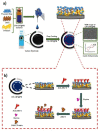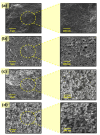A Redox-Probe-Free Immunosensor Based on Electrocatalytic Prussian Blue Nanostructured Film One-Step-Prepared for Zika Virus Diagnosis
- PMID: 36005020
- PMCID: PMC9406047
- DOI: 10.3390/bios12080623
A Redox-Probe-Free Immunosensor Based on Electrocatalytic Prussian Blue Nanostructured Film One-Step-Prepared for Zika Virus Diagnosis
Abstract
The Zika virus (ZIKV) is a great concern for global health due to its high transmission, including disseminating through blood, saliva, urine, semen and vertical transmission. In some cases, ZIKV has been associated with microcephaly, neurological disorders, and Guillain−Barré syndrome. There is no vaccine, and controlling the disease is a challenge, especially with the co-circulation of the Dengue virus, which causes a severe cross-reaction due to the similarity between the two arboviruses. Considering that electrochemical immunosensors are well-established, sensitive, and practical tools for diagnosis, in this study we developed a sensor platform with intrinsic redox activity that facilitates measurement readouts. Prussian blue (PB) has a great ability to form electrocatalytic surfaces, dispensing redox probe solutions in voltammetric measurements. Herein, PB was incorporated into a chitosan−carbon nanotube hybrid, forming a nanocomposite that was drop-casted on a screen-printed electrode (SPE). The immunosensor detected the envelope protein of ZIKV in a linear range of 0.25 to 1.75 µg/mL (n = 8, p < 0.01), with a 0.20 µg/mL limit of detection. The developed immunosensor represents a new method for electrochemical measurements without additional redox probe solutions, and it is feasible for application in point-of-care diagnosis.
Keywords: Prussian blue; Zika virus; envelope protein; immunosensor; point-of-care diagnosis.
Conflict of interest statement
The authors declare no conflict of interest.
Figures









Similar articles
-
A Label and Probe-Free Zika Virus Immunosensor Prussian Blue@carbon Nanotube-Based for Amperometric Detection of the NS2B Protein.Biosensors (Basel). 2021 May 16;11(5):157. doi: 10.3390/bios11050157. Biosensors (Basel). 2021. PMID: 34065688 Free PMC article.
-
NS1 glycoprotein detection in serum and urine as an electrochemical screening immunosensor for dengue and Zika virus.Anal Bioanal Chem. 2021 Aug;413(19):4873-4885. doi: 10.1007/s00216-021-03449-7. Epub 2021 Jun 21. Anal Bioanal Chem. 2021. PMID: 34152457
-
Highly sensitive and specific graphene/TiO2 impedimetric immunosensor based on plant-derived tetravalent envelope glycoprotein domain III (EDIII) probe antigen for dengue diagnosis.Biosens Bioelectron. 2021 Mar 15;176:112895. doi: 10.1016/j.bios.2020.112895. Epub 2020 Dec 15. Biosens Bioelectron. 2021. PMID: 33358432
-
Updating Zika Diagnostic Methods: The Point-of-Care Approach.Rev Invest Clin. 2020 Dec 22;72(6):344-352. doi: 10.24875/RIC.20000160. Rev Invest Clin. 2020. PMID: 33053568 Review.
-
Congenital Abnormalities: Consequence of Maternal Zika Virus Infection: A Narrative Review.Infect Disord Drug Targets. 2017;17(1):3-13. doi: 10.2174/1871526516666161018104916. Infect Disord Drug Targets. 2017. PMID: 27758685 Review.
Cited by
-
Production of Recombinant Zika Virus Envelope Protein by Airlift Bioreactor as a New Subunit Vaccine Platform.Int J Mol Sci. 2023 Sep 11;24(18):13955. doi: 10.3390/ijms241813955. Int J Mol Sci. 2023. PMID: 37762254 Free PMC article.
-
Electrochemical protein biosensors for disease marker detection: progress and opportunities.Microsyst Nanoeng. 2024 May 22;10:65. doi: 10.1038/s41378-024-00700-w. eCollection 2024. Microsyst Nanoeng. 2024. PMID: 38784375 Free PMC article. Review.
References
MeSH terms
Substances
Grants and funding
LinkOut - more resources
Full Text Sources
Medical

